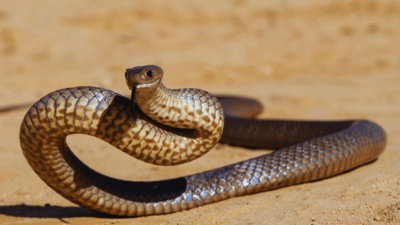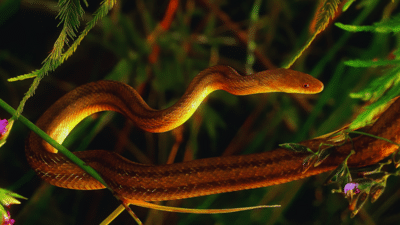Snakes have always fascinated and frightened people in equal measure. They have been symbols of danger, mystery, and survival, inciting curiosity and fear whenever spotted in the wild or anywhere. If we go by the records, there are more than 3,000 snake species across the world, out of which 600 are venomous that are capable of delivering a potentially deadly bite. Among them, some countries host only a handful, while others seem to have more than their fair share. According to Guinness World Records, no place on Earth has more venomous snakes than Australia, which is home to over 100 land-dwelling species and around 30 venomous sea snakes.
However, it’s interesting to note that while Australia boasts the world’s most venomous snakes, it is not the country where most people die from snakebites. Find out more here.
Australia’s deadly snake species The Inland Taipan (Oxyuranus microlepidotus)

Nicknamed the “fierce snake” or “small-scaled snake”, the inland taipan is widely regarded as the most venomous snake on Earth, based on the potency of its venom. A single bite contains enough toxins to kill multiple adult humans. Yet, ironically, this snake has never been responsible for a confirmed human fatality. Why? Its natural habitat is remote and arid, far removed from towns and cities, making encounters with humans extremely rare.
The Eastern Brown Snake (Pseudonaja textilis)

Far more concerning for Australians is the eastern brown snake. Although its venom is not quite as potent as the inland taipan’s, it is still extremely toxic, and the species is far more widespread. Eastern browns are often found in farmland and near human settlements, drawn by their preferred prey: mice. Their proximity to people makes them the most lethal snake in Australia, accounting for the majority of snakebite deaths.
Add to this lineup coastal taipans, tiger snakes, and a wide variety of sea snakes, and it’s easy to see why Australia has the reputation of being a land where everything slithers, stings, or bites.
Read more: 10 countries with most UNESCO World Heritage Sites
But are Australians really at risk?Despite its dangerous reputation, Australia is surprisingly safe when it comes to snakebite fatalities. According to the Australian Institute of Health and Welfare (AIHW), there were only seven deaths due to snakebites in 2017–18—out of 19 total deaths attributed to contact with venomous animals, as per AIHW. Additional data show that 1,500 suspected or definite snakebites occur annually in Australia, with only 200 cases requiring antivenom treatment, and about 2 to 4 fatalities per year.
This low death toll is thanks to three key factors:
Effective healthcare: Hospitals across Australia maintain robust supplies of antivenom and are staffed by personnel trained to handle envenomations promptly and effectively as per The Medical Journal of Australia.
Public awareness – Australians receive strong education on snake safety, from advising how to avoid contact to knowing what to do in the event of a bite.
Snake behaviour – Most snakes naturally retreat from human presence and only bite when provoked or cornered.
By comparison, India faces a much more sobering reality. While it has far fewer venomous species than Australia, it suffers from the highest snakebite fatality rate in the world, with an estimated 58,000 deaths every year from roughly 1 million bites. The reasons are largely due to rural populations living in close proximity to snakes, limited access to healthcare in remote areas, and cultural practices that may delay urgent treatment.
Read more: 10 stunning coastal getaways in the US
Tips for staying safe

Whether you’re trekking through the Australian outback, strolling in rural India, or exploring jungles elsewhere, a few simple rules can minimize risk:
Watch your step – Always look where you’re walking, especially in tall grass or near rocks.
Wear protective clothing – Long boots and thick socks reduce the chances of venom penetrating deeply.
Don’t provoke snakes – Most bites happen when people try to handle or kill snakes.
Seek help immediately – If bitten, immobilize the limb, stay calm, and get to a medical facility fast.
Learn local snake safety – In Australia, call emergency services; in India, head to the nearest hospital with antivenom supplies.
In short Australia has the most venomous snakes in the world , including the record-holding inland taipan. Yet thanks to awareness, healthcare, and geography, Australians rarely fall victim to them.
However, it’s interesting to note that while Australia boasts the world’s most venomous snakes, it is not the country where most people die from snakebites. Find out more here.
Australia’s deadly snake species The Inland Taipan (Oxyuranus microlepidotus)

Nicknamed the “fierce snake” or “small-scaled snake”, the inland taipan is widely regarded as the most venomous snake on Earth, based on the potency of its venom. A single bite contains enough toxins to kill multiple adult humans. Yet, ironically, this snake has never been responsible for a confirmed human fatality. Why? Its natural habitat is remote and arid, far removed from towns and cities, making encounters with humans extremely rare.
The Eastern Brown Snake (Pseudonaja textilis)
Far more concerning for Australians is the eastern brown snake. Although its venom is not quite as potent as the inland taipan’s, it is still extremely toxic, and the species is far more widespread. Eastern browns are often found in farmland and near human settlements, drawn by their preferred prey: mice. Their proximity to people makes them the most lethal snake in Australia, accounting for the majority of snakebite deaths.
Add to this lineup coastal taipans, tiger snakes, and a wide variety of sea snakes, and it’s easy to see why Australia has the reputation of being a land where everything slithers, stings, or bites.
Read more: 10 countries with most UNESCO World Heritage Sites
But are Australians really at risk?Despite its dangerous reputation, Australia is surprisingly safe when it comes to snakebite fatalities. According to the Australian Institute of Health and Welfare (AIHW), there were only seven deaths due to snakebites in 2017–18—out of 19 total deaths attributed to contact with venomous animals, as per AIHW. Additional data show that 1,500 suspected or definite snakebites occur annually in Australia, with only 200 cases requiring antivenom treatment, and about 2 to 4 fatalities per year.
This low death toll is thanks to three key factors:
Effective healthcare: Hospitals across Australia maintain robust supplies of antivenom and are staffed by personnel trained to handle envenomations promptly and effectively as per The Medical Journal of Australia.
Public awareness – Australians receive strong education on snake safety, from advising how to avoid contact to knowing what to do in the event of a bite.
Snake behaviour – Most snakes naturally retreat from human presence and only bite when provoked or cornered.
By comparison, India faces a much more sobering reality. While it has far fewer venomous species than Australia, it suffers from the highest snakebite fatality rate in the world, with an estimated 58,000 deaths every year from roughly 1 million bites. The reasons are largely due to rural populations living in close proximity to snakes, limited access to healthcare in remote areas, and cultural practices that may delay urgent treatment.
Read more: 10 stunning coastal getaways in the US
Tips for staying safe
Whether you’re trekking through the Australian outback, strolling in rural India, or exploring jungles elsewhere, a few simple rules can minimize risk:
Watch your step – Always look where you’re walking, especially in tall grass or near rocks.
Wear protective clothing – Long boots and thick socks reduce the chances of venom penetrating deeply.
Don’t provoke snakes – Most bites happen when people try to handle or kill snakes.
Seek help immediately – If bitten, immobilize the limb, stay calm, and get to a medical facility fast.
Learn local snake safety – In Australia, call emergency services; in India, head to the nearest hospital with antivenom supplies.
In short Australia has the most venomous snakes in the world , including the record-holding inland taipan. Yet thanks to awareness, healthcare, and geography, Australians rarely fall victim to them.
You may also like

Perishers - 18th August 2025

Mumbai Weather Update: City Lashed By Heavy Rains For Third Day, IMD Issues Red Alert For Raigad And Palghar

Olivia Pratt-Korbel's mum's emotional plea three years on from horrific shooting

Thousands more NHS checks, test and scans now offered out-of-hours

Weeds and dandelions won't spread or grow back bigger if you pour over 1 natural liquid





